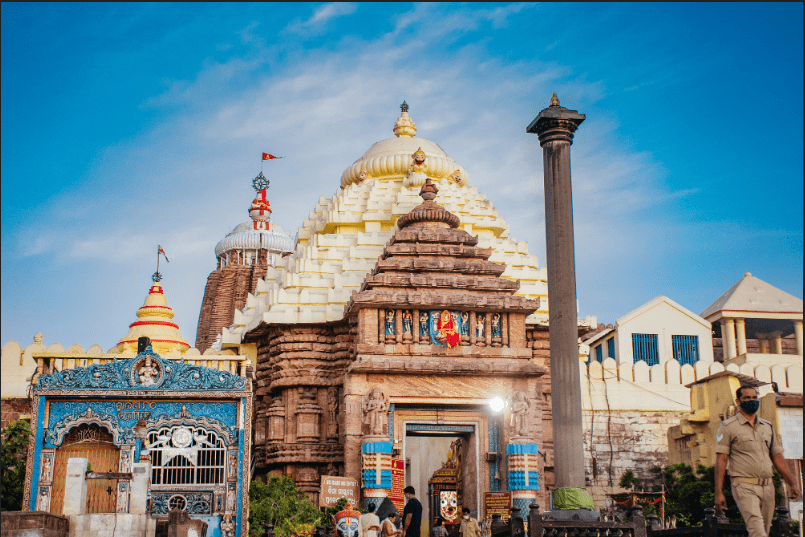
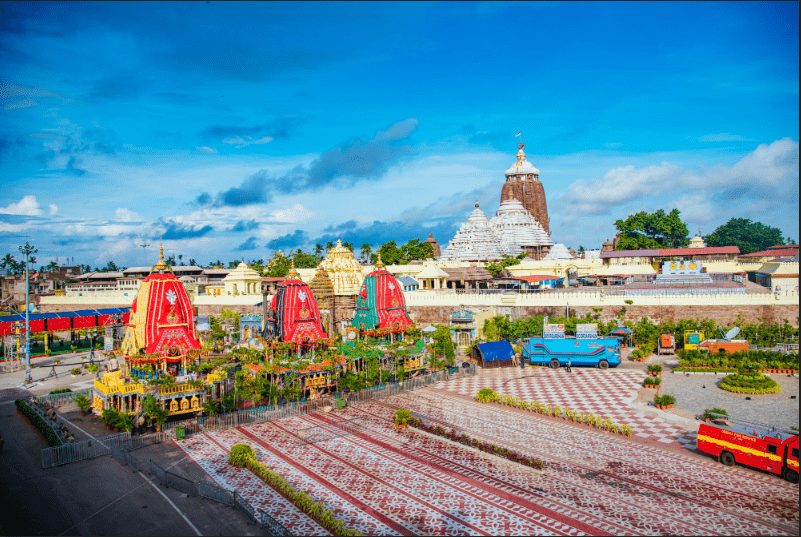
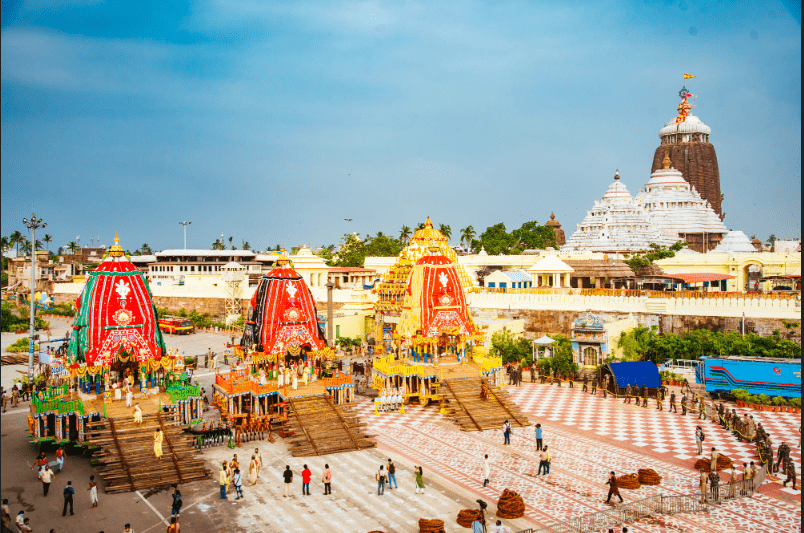
About Jagannath Mandir
- The Jagannath temple is situated in the Puri district at Odisha state. It is dedicated to Lord Krishna.
- The 4 dhams of India are Badrinath, Dwarka, Puri, and Rameshwaram. Puri is one of them. And these all four dhams are defined by Adi Shankaracharya.
- The temple worships Lord Jagannath, Devi Subhadra, and elder brother Balbhadra.
- The height of the temple is 65 m. and is constructed in the Kalinga structure. The temple was built by the King of the Ganga Dynasty, Anant Varman Chodaganga in the 12 century.
- There are so many festivals of Jagannath Temple, during the year are Rath Yatra, Chandan Yatra, Snana Yatra, and Nabakalebara. The most famous festival is Rath yatra. Many people gathered in this yatra to witness Lord Jagannath during the festival.
- It is a famous Hindu Temple.
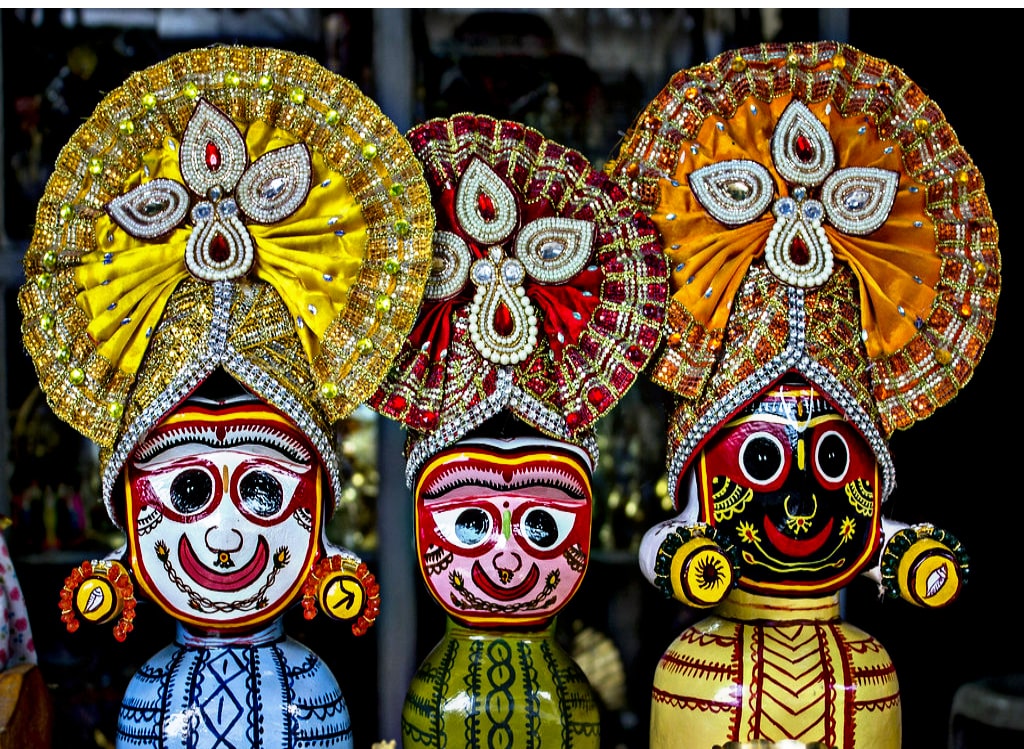
History of Jagannath Temple
- People say that a King named Indradyumna(son of Bharata and Sunanda) was the devotee of Lord Vishnu. Once he got to know that Lord Vishnu has come in the form of Neela Madhva and he has been worshipping by Vishwavasu. So he sent a Brahman Priest Vidyapati to find the deity, Vidyapati goes there and tried his best to find the deity, but he couldn’t succeed.
- Vishwavasu had a daughter named Lalita. He married her. After some time, he requested his wife to tell her father that to take him to Neela Madhva. Vishwavasu accepted the request of her daughter. He blindfolded him and took him to a cave where he worships Neela Madhva.
- Vidyapati was very brilliant. He took some mustard seeds with him and dropped them on the way whom they were going. and entered into the cave with Vishwavasu. After that, he informed Indradyumna so he came there and become disappointed because the deity was disappeared. But he wants to see deity so he observed fast unto death on Mount Neela. Once he heard a voice that he will see his deity. So he sacrificed a horse and built a temple for Vishnu. And the murti of Narsimha brought by Narada was installed in the temple.
- One night when he was sleeping, he saw Lord Jagannath in his dream. He heard a voice about a fragrant tree on the seaside and make idols of it. So he made the idol of Jagannath, Balbhadra, and Devi Subhadra and installed them in the temple.
- Then he prayed to Lord Brahma to visit the temple. Brahma came there and was happy for him. He asked the king that how he can fulfill his wish. He said that makes his life childless and he should be the last member of his family. If anybody left then he should work for the temple not for others.
Who Built the Jagannath Temple?
The temple was constructed by the Anant Varman Chodaganga, who was the king of the Ganga Dynasty. Later it was completed by King Anangabhima Deva in the 12th century.
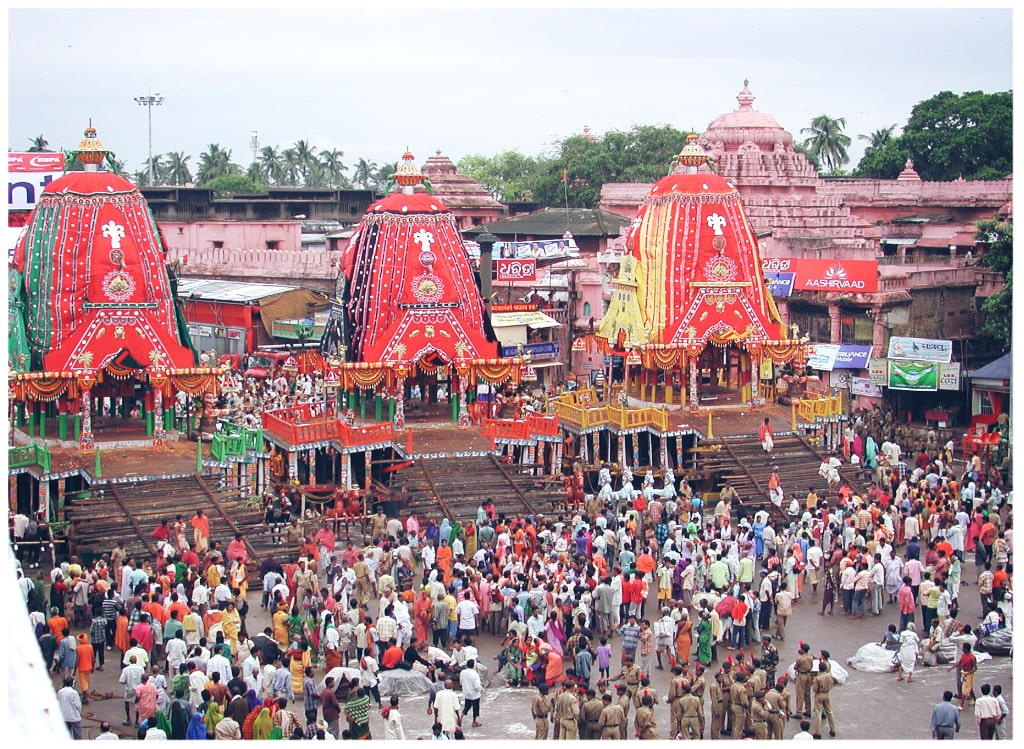
Why Jagannath Mandir is famous
- The temple is famous for its festival and Rath Yatra which is held annually. Thousands of people gather in this yatra and take the blessing of Lord Jagannath.
Festivals of Jagannath
- Every year there are some festivals which are celebrated in Jagannath. Among them, Rath Yatra is famous in which all three deities are carried to Gundicha Temple.
Chandan Yatra
- In this festival, the chariot is made for each deity. The festival is too long and it takes 42 days. The yatra is divided into Bahri Chandan and Bhitri Chandan Yatra. Each one takes 21 days to complete.
Snana Yatra
- In this festival, all three deities Lord Jagannath, Devi Subhadra, and Balbhadra taken to Snana Yatra and bathed them doing all rituals.
Anavasara
- It is celebrated after Snana Yatra in which the deities were taken to rest for 15 days. So devotees were not allowed there to see them. They can go to Brahmagiri to see their beloved Alternath form of Vishnu.
Rath Yatra
- After Anavasara the Rath Yatra is held. It is very famous and organized in the month of June or July. In Rath Yatra, all the deities are brought out into the street of Puri and travel to Shri Gundicha Temple. And the deities are carry on huge chariots(Rath). Jagannath’s chariot is approximately 13.5 meters, 12.9 meters for Devi Subhadra, and 13.2 meters for Balabhadra. There is a story about Rath Yatra. People say that it can be detected in Krishna’s childhood when he expresses his desire to go to his aunt’s house every year.
Nabakalebara
- Nabakalebara is a ritual held in 8, 12, or 18 years. In this festival, new images are installed in Jagannath, and old ones are buried out to Koili Vaikuntha Temple.
Rath Yatra Festival
Rath Yatra, the Festival of Chariots, is a spectacle of devotion, vibrant colors, and sheer human energy that captivates millions. Primarily associated with Lord Jagannath, his brother Balabhadra, and sister Subhadra, this annual festival, held in Puri, Odisha, India, is a celebration of divine journey and a testament to the enduring power of faith. Let’s delve into the heart of this magnificent cultural phenomenon.
A Journey to the Gundicha Temple:
The essence of Rath Yatra lies in the symbolic journey of the deities from the Jagannath Temple to the Gundicha Temple, believed to be their aunt’s abode. The idols, after a period of seclusion known as “Anavasara,” are ceremoniously brought out and placed on massive, elaborately decorated chariots called “Raths.” These chariots, constructed anew each year by a lineage of skilled carpenters, are a marvel of engineering and artistry.
- Nandighosha: Lord Jagannath’s chariot, a towering structure with sixteen wheels, is draped in red and yellow cloth.
- Taladhwaja: Balabhadra’s chariot, with fourteen wheels, is covered in blue and green.
- Darpadalana: Subhadra’s chariot, the smallest of the three, with twelve wheels, is draped in black and red.
The deities embark on their journey, pulled by thousands of devotees, creating a sea of humanity chanting hymns and expressing their devotion. This procession, known as “Pahandi Bije,” is a sight to behold, a confluence of faith and fervor.
Rituals and Traditions:
Rath Yatra is steeped in rich traditions and rituals, each carrying profound symbolic meaning.
- Chhera Pahara: The Gajapati King of Puri, considered the foremost servitor of Lord Jagannath, performs the ritual of sweeping the chariots with a golden broom. This act symbolizes that everyone is equal in the eyes of the Lord.
- Anavasara: Before the Rath Yatra, the deities are believed to fall ill after taking a bath with 108 pots of water (Snana Purnima). They are then secluded for fifteen days, a period known as “Anavasara,” during which they are offered only fruits and medicinal herbs.
- Gundicha Yatra: The deities stay at the Gundicha Temple for nine days, a period known as “Gundicha Yatra,” during which devotees offer them prayers and various delicacies.
- Bahuda Yatra: The return journey of the deities to the Jagannath Temple is called “Bahuda Yatra.” This marks the culmination of the festival.
- Suna Besha: After returning to the main temple, the deities are adorned with gold ornaments, a spectacle known as “Suna Besha.”
- Niladri Bije: The deities are then ceremoniously taken back to their sanctum sanctorum in the Jagannath Temple. This ritual marks the end of the Rath Yatra.
Jagannath Temple Prasad
The Mahaprasad of the Jagannath Temple in Puri is a sacred offering, deeply ingrained in the temple’s rituals and the devotees’ experience. Prepared in the temple’s kitchen, known as “Rosha Ghara,” it comprises a wide array of vegetarian dishes, traditionally cooked in earthen pots over wood fires. This “Chappan Bhog,” or 56 offerings, includes rice, lentils, vegetables, and sweets, all considered sanctified after being offered to Lord Jagannath, Balabhadra, and Subhadra. Distributed within the temple complex, particularly in Ananda Bazar, the Mahaprasad fosters a sense of unity, as people from all walks of life partake in this divine food, emphasizing its spiritual significance beyond mere sustenance.

Attractions Near Jagannath Temple
The Jagannath Temple in Puri, Odisha, is a major pilgrimage site, and the surrounding area offers a wealth of attractions for visitors.
- Puri Beach:
- Just a short distance from the Jagannath Temple, Puri Beach is a popular destination for both pilgrims and tourists.
- It’s known for its golden sands, beautiful sunrises and sunsets, and the vibrant atmosphere of local vendors and activities.
- The beach is also famous for the sand art of Sudarshan Pattnaik.
- Just a short distance from the Jagannath Temple, Puri Beach is a popular destination for both pilgrims and tourists.
- Konark Sun Temple:
- A UNESCO World Heritage Site, the Konark Sun Temple is an architectural marvel located about an hour’s drive from Puri.
- This 13th-century temple is designed as a massive chariot dedicated to the sun god Surya, with intricate carvings and sculptures.
- A UNESCO World Heritage Site, the Konark Sun Temple is an architectural marvel located about an hour’s drive from Puri.
- Chilika Lake:
- Asia’s largest brackish water lagoon, Chilika Lake is a haven for nature lovers.
- It’s home to a diverse range of flora and fauna, including migratory birds and Irrawaddy dolphins.
- Boat trips on the lake offer stunning views of the surrounding landscapes and wildlife.
- Asia’s largest brackish water lagoon, Chilika Lake is a haven for nature lovers.
- Gundicha Temple:
- This temple plays a significant role in the Rath Yatra festival, as it’s where Lord Jagannath and his siblings reside for a week.
- It’s also known as the “Garden House” of Lord Jagannath.
- This temple plays a significant role in the Rath Yatra festival, as it’s where Lord Jagannath and his siblings reside for a week.
- Sakshigopal Temple:
- A medieval temple dedicated to Lord Gopinath, located a short distance from Puri.
- Swargadwar Market:
- A bustling market located near Puri Beach, offering a variety of local handicrafts, souvenirs, and food.
- A bustling market located near Puri Beach, offering a variety of local handicrafts, souvenirs, and food.
These attractions provide a blend of spiritual, cultural, and natural experiences, making a visit to Puri a memorable one.
How to Reach Jagannath Temple?
The majestic Jagannath Temple in Puri, Odisha, India, beckons millions of devotees and curious travelers each year. Its spiritual significance, architectural grandeur, and the vibrant culture surrounding it make it a must-visit destination. But how exactly do you reach this sacred abode? Let’s break down the various travel options to help you plan your pilgrimage or adventure.
1. By Air: The Fastest Route
- Biju Patnaik International Airport (BBI), Bhubaneswar: This is the nearest major airport, located approximately 60 kilometers from Puri. It offers excellent connectivity with major Indian cities like Delhi, Mumbai, Kolkata, Chennai, and Bangalore.
- From Bhubaneswar Airport to Puri:
- Taxi/Cab: You can hire a pre-paid taxi or a private cab from the airport. This is the most convenient option, taking about 1.5 to 2 hours, depending on traffic.
- Bus: Odisha State Road Transport Corporation (OSRTC) and private buses operate regular services from Bhubaneswar to Puri. These are a more budget-friendly option, although the journey may take longer.
- Train: Bhubaneswar Railway Station is well connected from the airport. You can take a train from Bhubaneswar to Puri.
2. By Train: A Scenic Journey
- Puri Railway Station (PURI): Puri has its own railway station, well-connected to major cities across India. Direct trains are available from cities like Delhi, Kolkata, Mumbai, Ahmedabad, and Bangalore.
- Advantages: Train travel is often a comfortable and affordable option, especially for long distances. It also allows you to enjoy the scenic beauty of the Indian countryside.
- Booking: It’s advisable to book your train tickets well in advance, especially during peak seasons like the Rath Yatra.
3. By Road: Exploring Odisha’s Charm
- National Highways: Puri is well-connected by a network of national and state highways. NH316 and other roads provide smooth connectivity.
- Bus:
- OSRTC and private bus operators run regular services to Puri from various cities in Odisha and neighboring states like West Bengal, Andhra Pradesh, and Chhattisgarh.
- Buses offer a budget-friendly way to reach Puri, but travel times can vary.
- Car/Taxi:
- Driving to Puri offers flexibility and the opportunity to explore other destinations along the way.
- You can hire a taxi or drive your own car. Be mindful of road conditions and traffic, especially during festivals.
4. Local Transportation in Puri:
- Auto-rickshaws: These are readily available and a convenient way to travel within Puri. Negotiate the fare before you start your journey.
- Cycle-rickshaws: A traditional and eco-friendly way to explore the city’s narrow lanes and local markets.
- Taxis: Taxis are available for longer distances or for day trips to nearby attractions.
- Walking: Puri is a relatively compact city, and many attractions, including the Jagannath Temple, are within walking distance of each other.
Tips for Your Journey:
- Plan Ahead: Book your travel and accommodation in advance, especially during peak seasons like the Rath Yatra.
- Check Weather Conditions: Odisha’s weather can be hot and humid, particularly during the summer months. Pack accordingly.
- Respect Local Customs: Dress modestly when visiting the temple and other religious sites.
- Stay Hydrated: Carry water bottles and stay hydrated, especially during the summer.
- Bargain Fairly: When using auto-rickshaws or cycle-rickshaws, negotiate the fare reasonably.
- Enjoy the Local Cuisine: Don’t miss the opportunity to savor the delicious Odia cuisine, especially the famous “Mahaprasad” at the Jagannath Temple.
Reaching the Jagannath Temple is the beginning of a memorable spiritual and cultural experience. Whether you choose to fly, take a train, or drive, the journey itself can be a part of the adventure. May your pilgrimage to Lord Jagannath be blessed and fulfilling!
Frequently Asked Questions (FAQs)
1. What is the significance of the Jagannath Temple?
- The Jagannath Temple is one of the Char Dham pilgrimage sites, considered the most sacred Hindu sites in India. It is dedicated to Lord Jagannath, a form of Lord Vishnu, and is renowned for its annual Rath Yatra (Chariot Festival).
2. Who are the deities worshipped in the Jagannath Temple?
- The main deities worshipped are Lord Jagannath, his elder brother Balabhadra, and his sister Subhadra. They are represented by unique wooden idols.
3. What is the Rath Yatra, and when does it take place?
- The Rath Yatra is an annual chariot festival where the deities are taken out of the temple and carried in grand chariots to the Gundicha Temple. It usually takes place in June or July, during the Ashadha month.
4. What is the Mahaprasad of Jagannath Temple?
- Mahaprasad is the sacred food offered to Lord Jagannath and then distributed among devotees. It is cooked in earthen pots on wood fire in the temple kitchen and is considered highly auspicious.
5. What is unique about the temple’s flag (Neelachakra)?
- The Neelachakra, the flag atop the temple, always flies against the direction of the wind. Also, it is changed everyday. The flag is also unique because of the ritual of a priest climbing the temple to change it without any safety equipment.
6. Are non-Hindus allowed inside the Jagannath Temple?
- Traditionally, non-Hindus are not allowed inside the main temple premises. However, there are viewing platforms outside the temple from where they can see the temple’s exterior.
7. What is the history of the Jagannath Temple?
- The temple’s history dates back to the 12th century, built by King Anantavarman Chodaganga Deva of the Eastern Ganga Dynasty. However, the worship of Jagannath predates the current temple structure.
8. What are the main festivals celebrated at the Jagannath Temple?
- Besides the Rath Yatra, other major festivals include Snana Yatra, Navakalevara (the periodic renewal of the deities’ wooden idols), and Chandan Yatra.
9. What are the timings of the Jagannath Temple?
- The temple generally opens early in the morning, around 5:00 AM, and closes late at night, around 12:00 AM. However, timings may vary during festivals.
10. What are some of the architectural features of the Jagannath Temple?
- The temple is a magnificent example of Kalinga architecture, with its towering spire, intricate carvings, and the famous Neelachakra. The temple complex includes several smaller shrines and halls.


